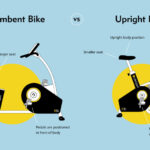Choosing the right bike size is paramount for comfort, performance, and injury prevention, whether you’re buying your first bicycle or upgrading to a new model. Understanding how bike frames are measured is essential to ensure you get a bike that fits you perfectly and suits your riding style. This knowledge becomes particularly useful when renting a bike or considering a second-hand purchase, allowing you to confidently assess if a bike is the right fit before you even hop on.
Bike manufacturers don’t always use a uniform sizing system. Therefore, relying on generic size labels can be misleading. To make accurate comparisons and informed decisions, it’s crucial to familiarize yourself with the fundamental measurements that define a bike frame’s dimensions.
This guide will walk you through the essential bike geometry measurements for both road bikes and mountain bikes, empowering you to accurately size up any bicycle frame. By understanding these measurements, you’ll be better equipped to choose the perfect bike and optimize your riding experience. Furthermore, we encourage you to explore our detailed guides on mountain bike geometry, road bike sizing, mountain bike sizing, and women’s bike sizes for more in-depth information.
Key Bike Geometry Measurements Explained
Before we delve into the practical steps of measuring a bike frame, let’s define the key measurements you’ll need to understand:
- Top Tube Length (Effective): This is the horizontal distance from the center of the head tube to the center of the seat post. It’s often referred to as the virtual top tube length and is a crucial factor in determining the bike’s reach and overall fit.
- Seat Tube Length: Measured from the center of the bottom bracket to the top of the seat tube, this measurement traditionally indicated frame size. However, with modern frame designs, it’s less indicative of overall fit but still a relevant metric.
- Reach: Reach is the horizontal distance from the center of the bottom bracket to the top-center of the head tube. It’s a crucial measurement for determining how stretched out you’ll be on the bike.
- Stack: Stack is the vertical distance from the center of the bottom bracket to the top-center of the head tube. It dictates the handlebar height relative to the bottom bracket, influencing your riding posture.
- Wheelbase: The wheelbase is the distance between the front and rear axle. It affects the bike’s stability and handling characteristics. A longer wheelbase generally provides more stability, while a shorter one can make the bike feel more agile.
- Chainstay Length: This is the distance from the center of the bottom bracket to the rear axle. Chainstay length influences the bike’s responsiveness and climbing ability. Shorter chainstays often result in a more responsive and nimble feel.
- Front Center: Measured from the center of the bottom bracket to the front axle, the front center contributes to the bike’s handling and stability, and impacts weight distribution.
- Seat Tube Angle: This is the angle of the seat tube relative to the ground. It influences your pedaling efficiency and weight distribution. A steeper seat tube angle positions the rider more forward over the pedals.
- Head Tube Angle: The angle of the head tube relative to the ground affects steering responsiveness and stability. A slacker head tube angle (more angled towards the front wheel) generally provides more stability, especially at higher speeds.
- Bottom Bracket Drop: Bottom bracket drop is the vertical distance the bottom bracket sits below the wheel axles. It influences the bike’s center of gravity and stability. A lower bottom bracket drop generally enhances stability.
- Bottom Bracket Height: This measurement is the distance from the ground to the center of the bottom bracket. It’s related to ground clearance and influences how the bike handles obstacles.
Tools You’ll Need for Bike Frame Measurement
To accurately measure a bike frame, you’ll need a few simple tools:
- Tape Measure: A standard retractable tape measure, preferably metric for accuracy.
- Clinometer (or Smartphone App): A clinometer measures angles. Smartphone apps are readily available and work effectively.
- Spirit Level (or Straight Edge & Clinometer App): A long spirit level ensures horizontal and vertical measurements. Alternatively, a straight piece of wood combined with a clinometer app can serve the same purpose.
- Plumb Line (or String & Weight): A plumb line helps establish a vertical reference. You can easily improvise with a piece of string and a small weight like a nut or washer.
While metric measurements are the standard in the cycling industry, some manufacturers, particularly for mountain bikes, might still use inches. To maintain consistency and avoid confusion, we recommend using metric units (centimeters or millimeters) throughout your measurements. If needed, conversion from centimeters to inches can be done by dividing by 2.54.
For modern bikes, geometry charts detailing all frame measurements are typically available on the manufacturer’s website. If your bike is a current model, consulting the official geometry chart is highly recommended as it provides the most accurate specifications.
Measuring Top Tube Length
 Demonstration of top tube measurement on a bike frame
Demonstration of top tube measurement on a bike frame
Alt Text: Measuring effective top tube length on a bicycle frame, showing the horizontal distance between the head tube and seat post centerlines using a tape measure and spirit level for accuracy.
The effective top tube length, or virtual top tube, is a standardized measurement crucial for bike sizing, especially as modern bike designs often incorporate sloping top tubes. While the actual top tube might be angled, the effective top tube length provides a horizontal measurement that allows for consistent comparisons across different frame styles.
To measure the effective top tube length, locate the center of your head tube and the center of your seat post. Using your tape measure, measure the horizontal distance between these two points. Crucially, use your spirit level or clinometer app to ensure your measurement is perfectly horizontal. This ensures accuracy and consistency, regardless of the top tube’s angle.
While some manufacturers size road bikes based on top tube length, mountain bikes and increasingly road bikes are often sized using S, M, L, XL designations. However, these size labels can vary significantly between brands. For instance, a size S frame from one brand might have a top tube length equivalent to a size M from another. Even within virtual top tube measurements, slight variations in methodology can occur between brands, highlighting the importance of understanding the specific measurements rather than relying solely on size labels.
Measuring Seat Tube Length
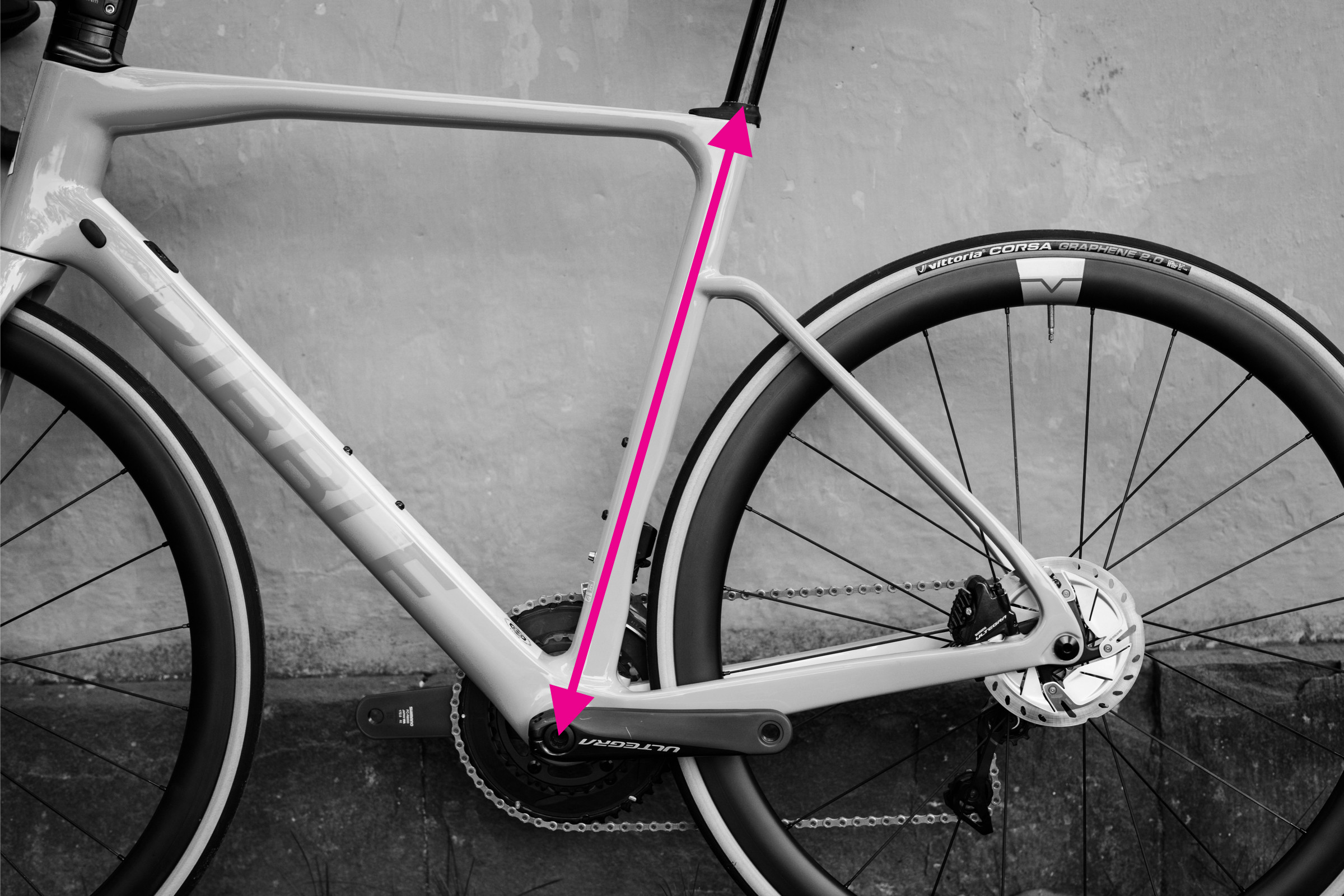 Demonstration of seat tube measurement on a bicycle frame
Demonstration of seat tube measurement on a bicycle frame
Alt Text: Measuring seat tube length on a bicycle frame, illustrating the straight-line distance from the bottom bracket center to the top of the seat tube with a tape measure.
Seat tube length is measured as the straight-line distance from the center of the bottom bracket to the top of the seat tube. While seemingly straightforward, certain frame designs can introduce complexities. Bikes with seat tube extensions above the top tube junction or those employing seat masts can make direct comparisons challenging.
Furthermore, mountain bikes often feature seat tubes with kinks or bends. When measuring, avoid following the contour of the tube itself, as this will yield an inaccurate, longer measurement. Instead, visualize a straight line extending from the bottom bracket center to the top of the seat tube. Use a straight edge to ensure you are measuring this direct, straight-line distance.
Measuring Reach and Stack
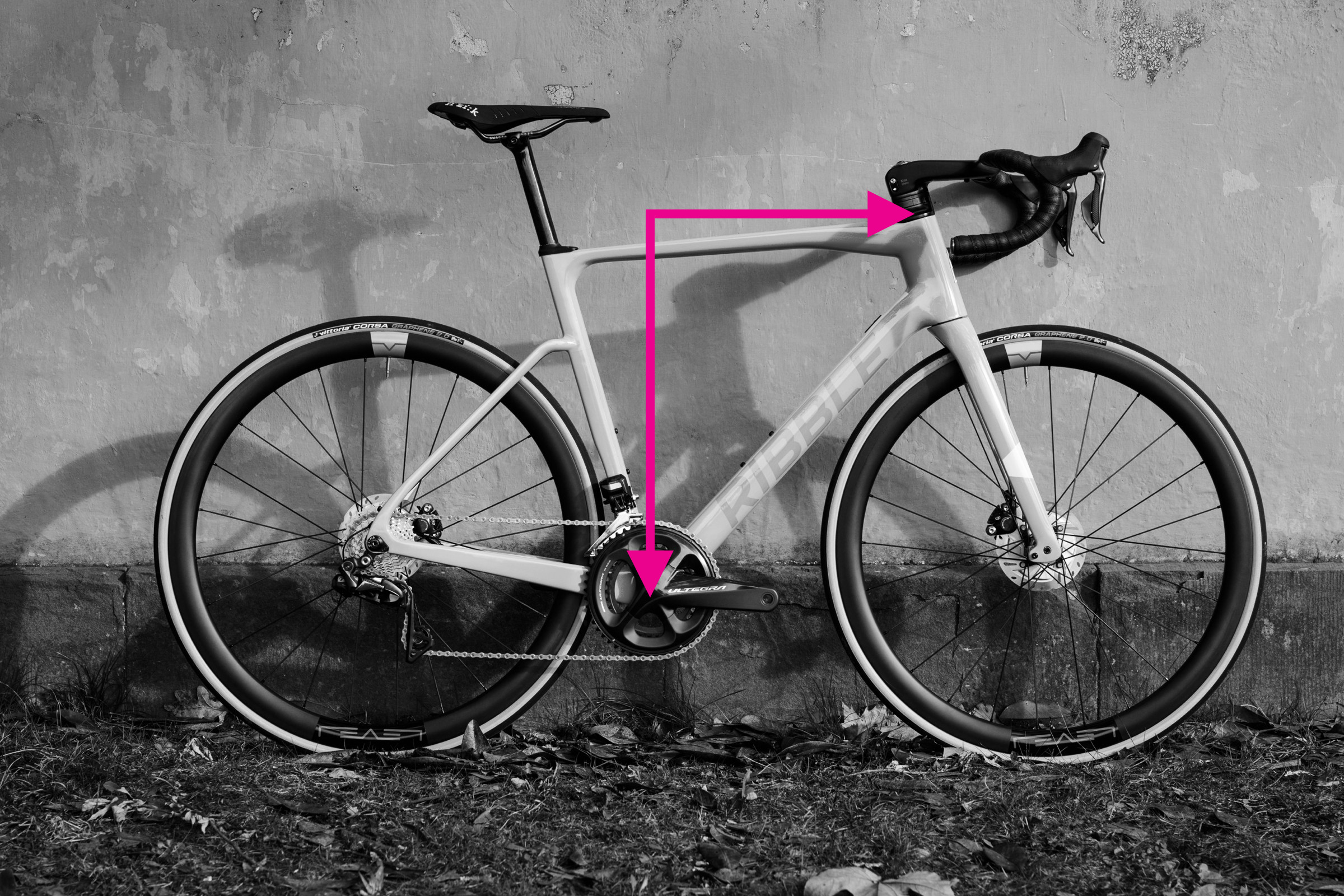 Demonstration of stack and reach measurements on a bike frame
Demonstration of stack and reach measurements on a bike frame
Alt Text: Measuring stack and reach on a bicycle frame, showing the vertical and horizontal distances from the bottom bracket to the top of the head tube using a plumb line, spirit level, and tape measure.
Reach and stack provide a more consistent and design-independent way to compare frame sizes compared to top tube and seat tube lengths. These measurements focus on the relationship between two key contact points: the bottom bracket and the top of the head tube.
Reach, the horizontal distance, determines how far you’ll be stretched out on the bike. Stack, the vertical distance, dictates the handlebar height relative to the bottom bracket. For a deeper understanding of the significance of reach and stack, refer to resources explaining why top tube length can be misleading.
To measure reach, position your spirit level horizontally at the top of the head tube. Attach a plumb line to the level, ensuring it hangs straight and symmetrically. Adjust the level until the plumb line precisely intersects the center of the bottom bracket spindle. The horizontal distance from the top of the plumb line to the head tube is your reach measurement.
Stack can be measured concurrently. With the same setup used for reach, the vertical distance from the spirit level at the head tube down to the bottom bracket center along the plumb line represents your stack measurement.
An alternative method for reach involves positioning your bike against a wall, measuring the horizontal distance from the wall to the top of the head tube and then to the bottom bracket. The difference between these two measurements gives you the reach. For stack, measure the vertical distance from the ground to the top of the head tube and then to the bottom bracket. Subtracting the latter from the former gives you the stack.
Due to the precision required, measuring reach and stack can be slightly challenging and may benefit from an extra pair of hands, particularly when using the plumb line method. Repeating the measurements ensures consistency and accuracy.
Measuring Wheelbase
 Demonstration of wheelbase measurement on a bike frame
Demonstration of wheelbase measurement on a bike frame
Alt Text: Measuring wheelbase on a bicycle frame, demonstrating the distance between the front and rear axle using a tape measure along the ground.
Wheelbase, the distance between the front and rear axles, significantly influences a bike’s ride quality and varies with frame size. It’s a key determinant of stability and handling.
Measuring wheelbase is relatively straightforward. Ensure the front fork is pointing straight ahead to obtain an accurate measurement. Using your tape measure, measure the distance from the front axle to the rear axle, running the tape along the ground.
For increased accuracy, especially if there’s any slight fork misalignment, measure the wheelbase on both sides of the bike and calculate the average. This helps to compensate for minor inconsistencies and provides a more precise wheelbase value.
Measuring Chainstay Length
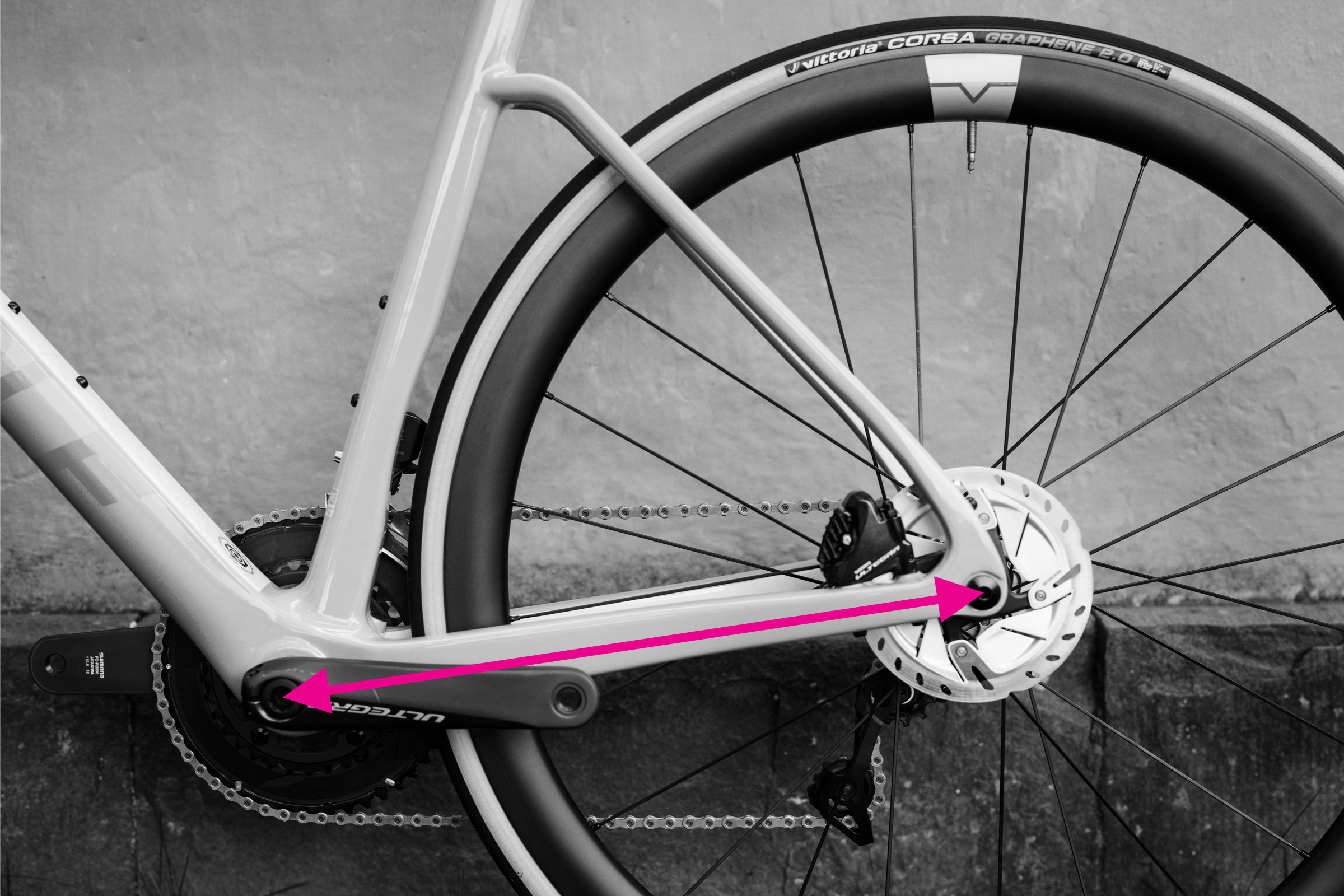 Demonstration of chainstay length measurement on a bike frame
Demonstration of chainstay length measurement on a bike frame
Alt Text: Measuring chainstay length on a bicycle frame, showing the distance from the bottom bracket center to the rear dropout center using a tape measure.
Chainstay length, a component of the wheelbase, plays a significant role in a bike’s handling characteristics. Shorter chainstays generally contribute to a more responsive and lively feel, while longer chainstays can enhance stability.
To measure chainstay length, locate the center of the bottom bracket axle and the center of the rear dropout. Using your tape measure, measure the straight-line distance between these two points. This measurement represents the chainstay length.
Measuring Front Center
 Demonstration of front center measurement on a bike frame
Demonstration of front center measurement on a bike frame
Alt Text: Measuring front center on a bicycle frame, illustrating the distance from the bottom bracket center to the front dropout center using a tape measure.
Front center is the counterpart to chainstay length, representing the distance from the center of the bottom bracket to the front axle. It also influences handling and contributes to factors like toe overlap (the potential for your shoe to hit the front wheel during tight turns).
While not always specified by bike manufacturers, front center is a relevant measurement for understanding bike geometry. Brands like BMC often include it in their geometry charts. It’s important to note that the wheelbase is not simply the sum of chainstay length and front center because these measurements are not taken along a purely horizontal plane.
To measure front center, find the center of the bottom bracket axle and the center of the front dropout. Measure the straight-line distance between these two points to determine the front center measurement.
Measuring Seat Tube and Head Tube Angles
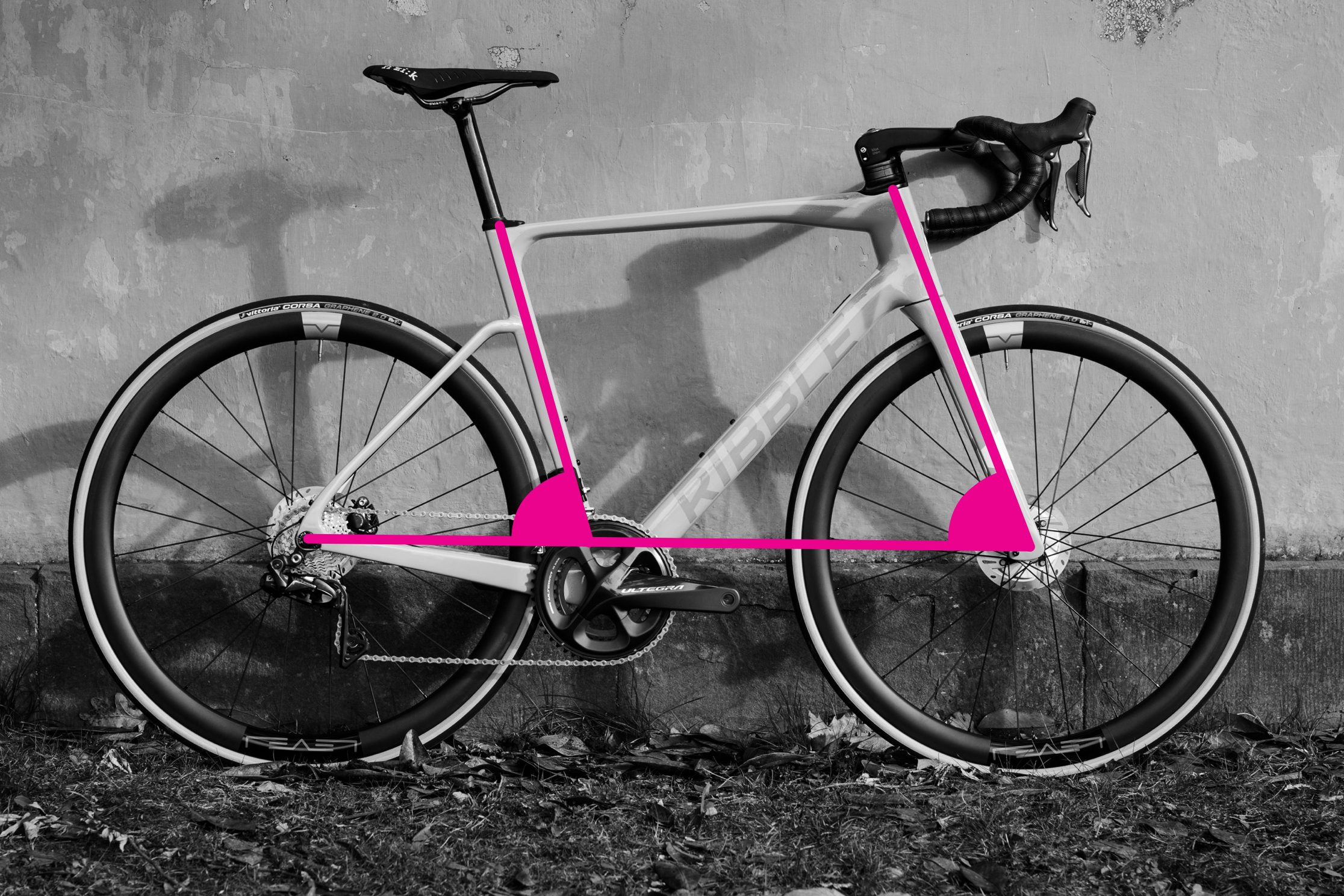 Demonstration of seat tube and head tube angle measurements on a bike frame
Demonstration of seat tube and head tube angle measurements on a bike frame
Alt Text: Measuring seat tube and head tube angles on a bicycle frame using a clinometer app on a smartphone to determine the angles relative to the horizontal plane.
Seat tube and head tube angles are critical factors influencing a bike’s handling. Steeper angles generally result in more nimble and responsive handling, while slacker angles provide greater stability, particularly at higher speeds. Your clinometer app is essential for measuring these angles.
For seat tube angle measurement, if your seat tube is straight, simply align your smartphone along the tube and read the angle from the clinometer app. Ensure your bike is vertical and on a level surface for accurate readings. If the seat tube has a kink, use a straight edge to create a straight line from the bottom bracket shell to the top of the seat tube, and then align your phone with this straight edge.
Head tube angle measurement can be slightly more complex due to tapered head tubes common in modern bikes. The angle of the front of the head tube might differ from the angle of its centerline. To approximate the centerline angle, try to align your phone with the visual centerline or use a straight edge aligned with the centers of the top and bottom of the head tube. Alternatively, if your bike has straight fork legs without a crown angle, you can measure the angle of the fork legs as they will closely match the head tube angle. Again, ensure the bike is perfectly vertical for accurate angle measurements. You can also measure the head tube angle by aligning the clinometer with the steerer tube extension above the head tube.
Measuring Bottom Bracket Drop
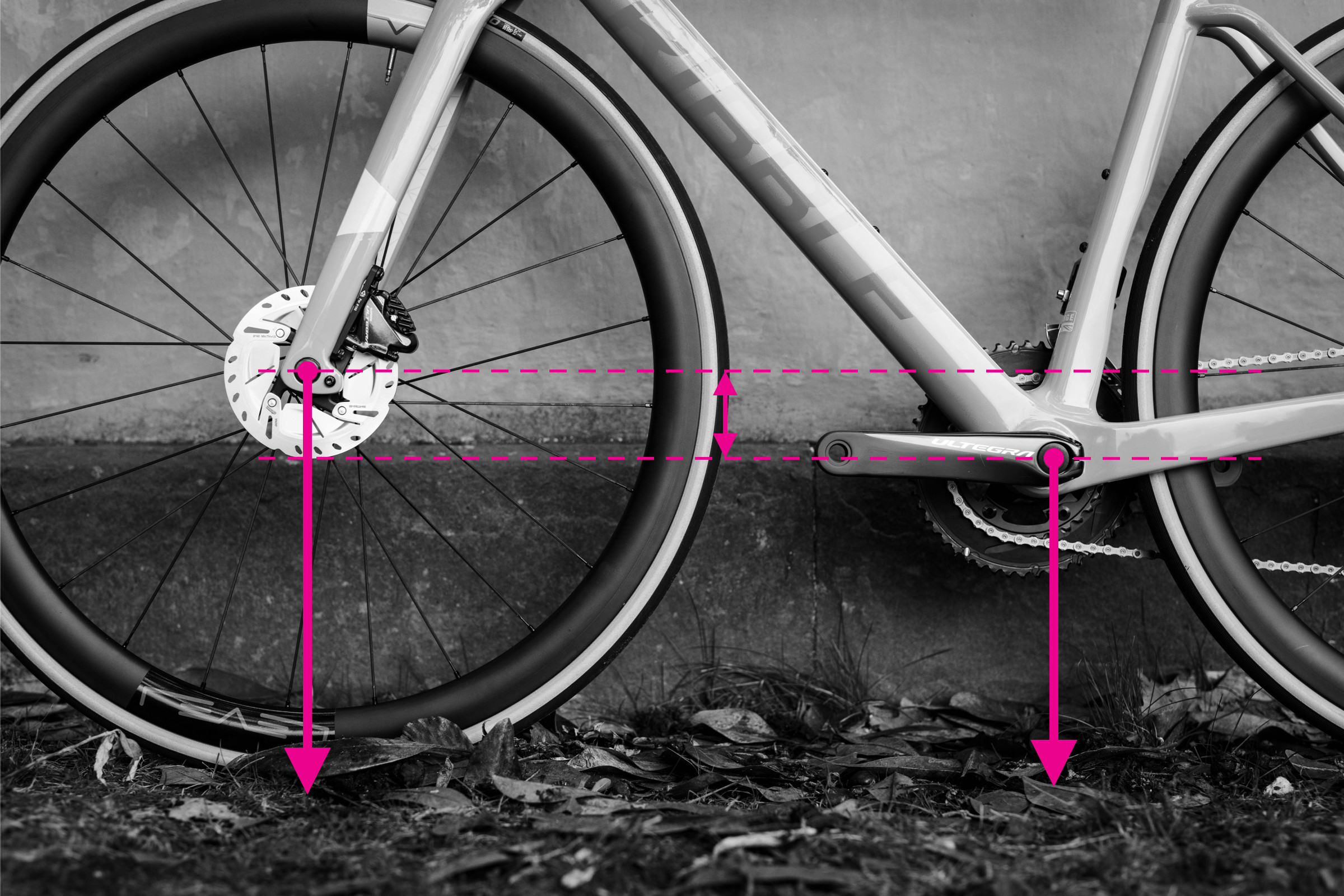 Demonstration of bottom bracket drop measurement on a bike frame
Demonstration of bottom bracket drop measurement on a bike frame
Alt Text: Measuring bottom bracket drop on a bicycle frame, illustrating the vertical distance difference between the wheel axle height and the bottom bracket axle height using a tape measure.
Bottom bracket drop is the vertical distance that the bottom bracket sits below the wheel axles. It’s a crucial measurement often included in bike geometry charts and influences the bike’s center of gravity and stability.
To measure bottom bracket drop, first measure the height of the rear axle from the ground and then measure the height of the bottom bracket from the ground. Subtract the bottom bracket height from the rear axle height. The resulting value is the bottom bracket drop.
Measuring Bottom Bracket Height
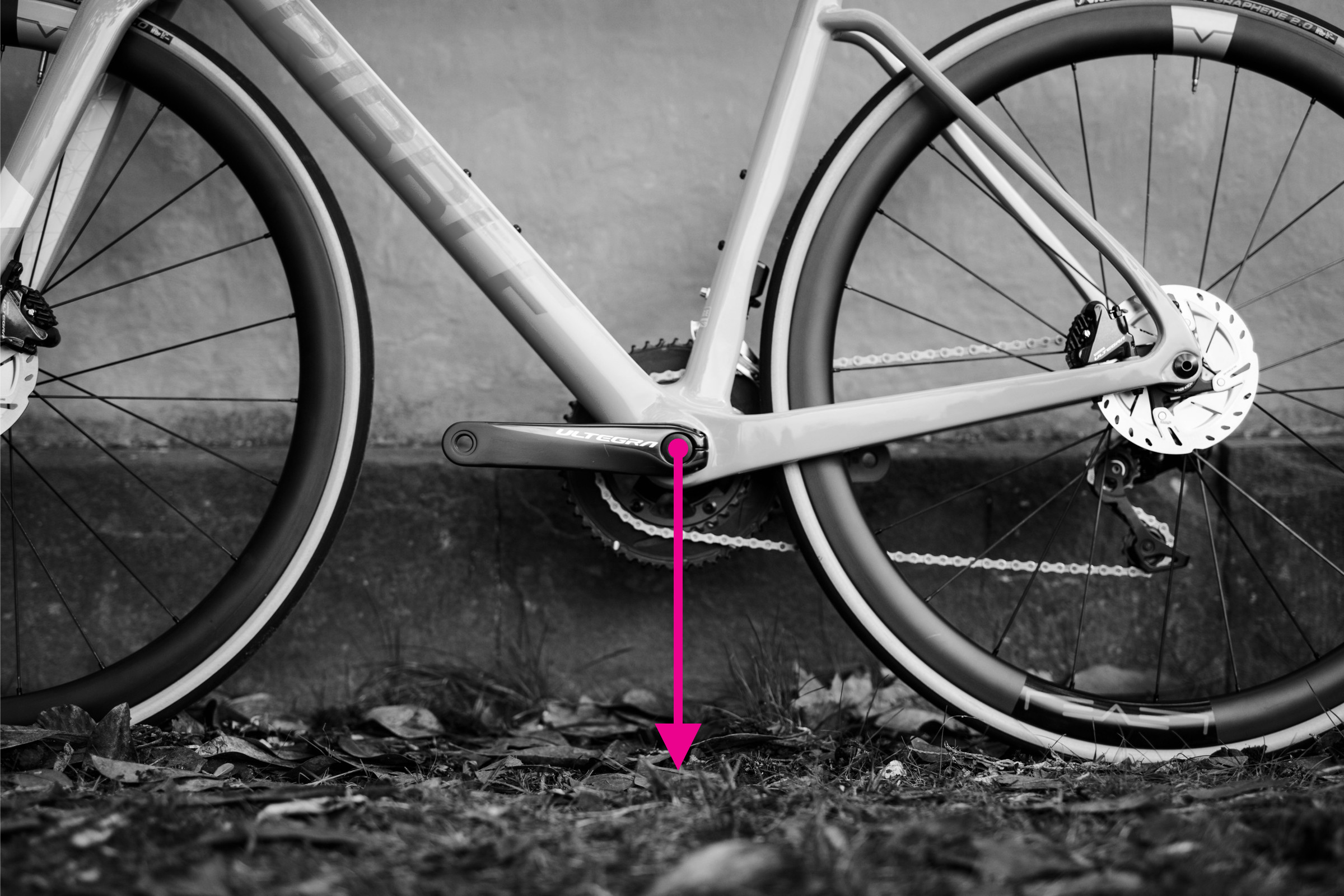 Demonstration of bottom bracket height measurement on a bike frame
Demonstration of bottom bracket height measurement on a bike frame
Alt Text: Measuring bottom bracket height on a bicycle frame, showing the vertical distance from the ground to the center of the bottom bracket using a tape measure.
Bottom bracket height is simply the distance from the ground to the center of the bottom bracket shell. This measurement is relatively easy to obtain but ensure your bike is upright and on level ground for an accurate reading.
It’s worth noting that bottom bracket height can be slightly influenced by tire size and pressure. For consistent measurements, inflate your tires to your standard riding pressure before measuring bottom bracket height.
By taking these key measurements, you’ll have a comprehensive understanding of a bike frame’s dimensions. This knowledge is invaluable when making informed purchasing decisions, whether for a new or second-hand road bike, commuting bike, or gravel bike. Keep your measurements recorded in a safe place for future reference, saving you the need to repeat the process each time you consider a new bike.


